Jabil Circuit Bundle
How did Jabil Circuit become a global manufacturing giant?
Journey back in time to uncover the fascinating Jabil Circuit SWOT Analysis, a company that began in a suburban Detroit kitchen and transformed into a Fortune 150 powerhouse. This brief history of Jabil Circuit company explores its humble beginnings in 1966, assembling circuit boards, to its current status as a leading provider of manufacturing services worldwide. Discover the key milestones and strategic decisions that shaped Jabil's remarkable evolution.
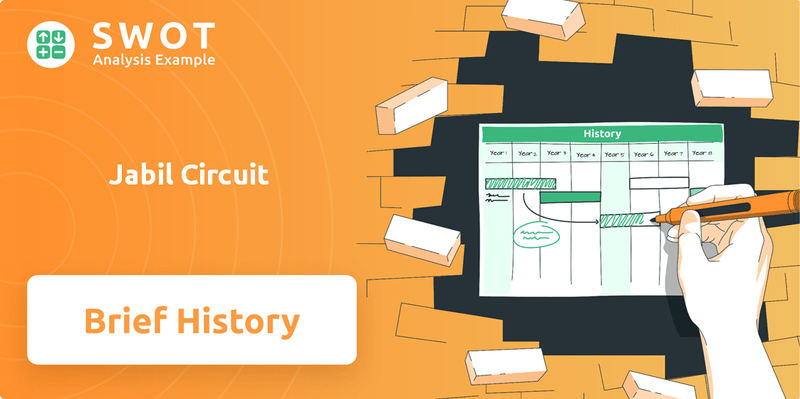
From its early years focused on circuit board assemblies, Jabil's history is a testament to its adaptability and strategic vision. The company's expansion through strategic acquisitions and diversification into various industries, including healthcare and automotive, has solidified its position. Understanding the Jabil company timeline reveals a narrative of continuous innovation and a commitment to meeting the evolving needs of its global clients, making it a crucial player in the manufacturing landscape.
What is the Jabil Circuit Founding Story?
The story of Jabil Circuit, now known as Jabil Inc., began in 1966 in the suburbs of Detroit, Michigan. It was founded by William E. Morean and James Golden. The name 'Jabil' itself is a blend of the founders' first names, James and Bill.
With an initial investment of just $5,000, the company started with a focus on producing and repairing circuit board assemblies. This marked the beginning of what would become a global manufacturing powerhouse. Understanding the Growth Strategy of Jabil Circuit provides deeper insights into its evolution.
Jabil's early days were marked by a focus on circuit board production and repair. Their first significant client was Control Data Systems, a major player in mainframe computers. This early partnership set the stage for future collaborations and growth.
Key milestones in Jabil's early years shaped its trajectory.
- James Golden's departure led to William D. Morean, William's son, joining in 1977.
- A pivotal partnership with General Motors (GM) in 1979 drove a shift towards advanced assembly technology.
- The company transitioned from manual circuit board assembly to highly automated processes.
- Jabil adopted a turn-key service model, handling parts procurement and engineering for high-volume production.
The partnership with General Motors in 1979 was a turning point. This collaboration pushed Jabil to embrace advanced assembly technology and automated manufacturing. This shift away from manual circuit board assembly was a strategic move.
The turn-key service model became a core offering. Jabil began procuring all necessary parts and providing engineering for high-volume production. This comprehensive approach helped solidify its position in the market.
Jabil Circuit SWOT Analysis
- Complete SWOT Breakdown
- Fully Customizable
- Editable in Excel & Word
- Professional Formatting
- Investor-Ready Format
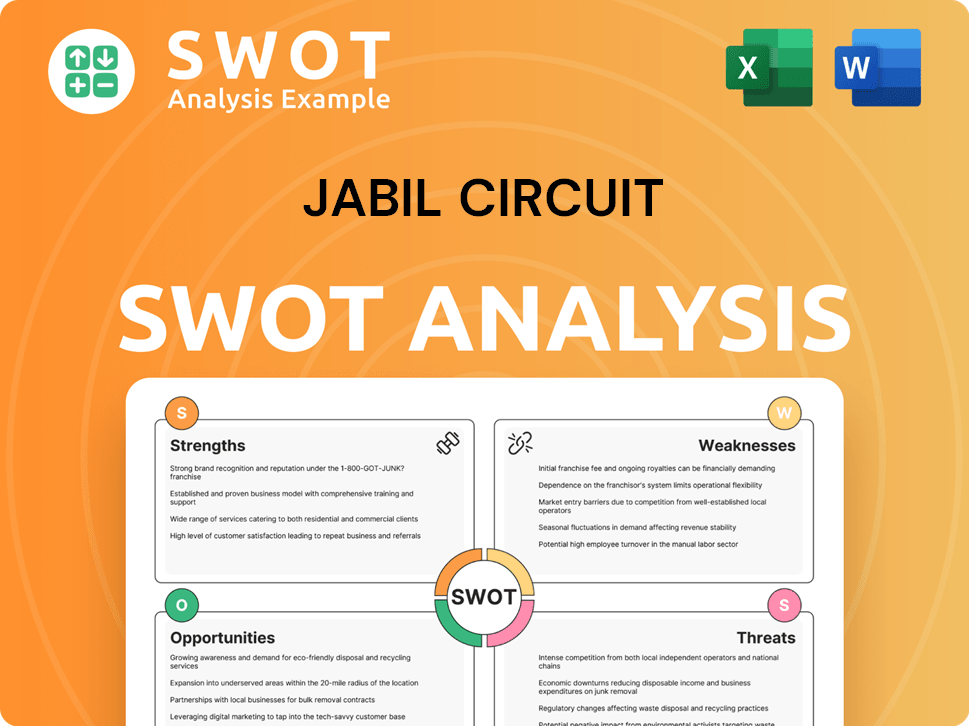
What Drove the Early Growth of Jabil Circuit?
The early years of the Jabil Circuit company were marked by significant technological advancements and strategic partnerships. This period saw the company expanding its capabilities and establishing a strong foundation for future growth. Key decisions and strategic moves during this time were instrumental in shaping the company's trajectory as a global manufacturing services provider.
In 1981, Jabil manufacturing introduced independent test engineering and development services. By 1982, it began volume production of circuit boards using manual surface-mount technology (SMT) processes. The company enhanced its capabilities with computer-aided design services in 1984 and transitioned to highly automated SMT processes in 1985. The late 1980s saw the adoption of the automated tape-automated bonding (TAB) process for circuit board production.
In 1982, Jabil Circuit relocated its headquarters from Detroit to St. Petersburg, Florida. This move was influenced by a contract to manufacture add-on circuit boards for IBM. Financial performance in the late 1980s showed fluctuations, with net income of $3.8 million on sales of $96 million in fiscal year 1988.
A major milestone for Jabil company was its public listing on the New York Stock Exchange in April 1993. This provided access to capital markets. By the mid-1990s, the workforce grew by 30% to over 2,000 employees, reflecting rapid growth.
The company expanded globally with acquisitions. In 1999, Jabil acquisitions included GET Manufacturing Inc. of Hong Kong for $250 million, pushing revenues past $2 billion. Further expansion included Intel's manufacturing facility in Malaysia in 2001, and a Lucent Technologies factory in Shanghai in 2002. By 2002, revenues exceeded $3.5 billion.
Jabil Circuit PESTLE Analysis
- Covers All 6 PESTLE Categories
- No Research Needed – Save Hours of Work
- Built by Experts, Trusted by Consultants
- Instant Download, Ready to Use
- 100% Editable, Fully Customizable
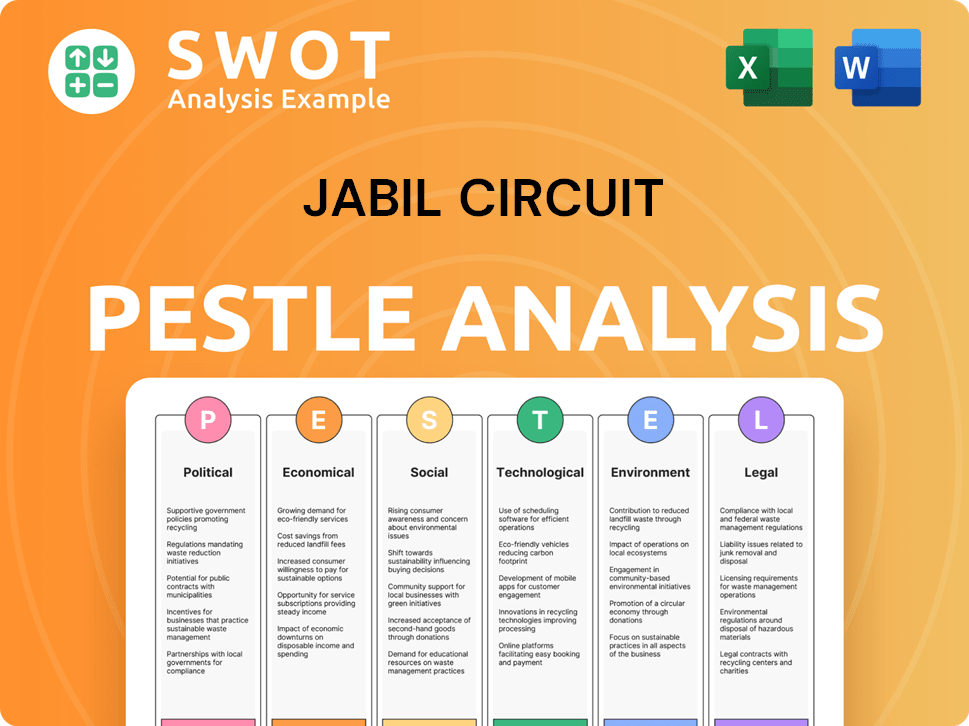
What are the key Milestones in Jabil Circuit history?
The Jabil Circuit company's journey is marked by several important milestones that have shaped its growth and influence in the electronics manufacturing services (EMS) industry. From its early beginnings to its current status as a major player, Jabil history is full of significant achievements and strategic moves.
| Year | Milestone |
|---|---|
| 2001 | Jabil Circuit was added to the S&P 500 Index, reflecting its growing market presence and financial success. |
| 2006 | Jabil Optics acquired Sypro Optics, marking an early step in its expansion into advanced optical solutions. |
| 2015 | Kasalis was acquired, further consolidating Jabil's optics business and enhancing its capabilities in advanced optical technologies. |
| 2025 | In February, Jabil acquired Pharmaceutics International, Inc. (Pii), expanding into the healthcare sector. |
Jabil has consistently pursued innovation, particularly in optics and automation. The company's focus on cutting-edge technologies is evident in its product developments and strategic partnerships.
In 2008, Jabil developed the smallest smartphone implementation of a Pico-projector, showcasing its expertise in miniaturization and advanced technology. This innovation highlighted Jabil's ability to integrate complex technologies into compact devices.
In 2012, Jabil introduced an automotive Head-Up Display (HUD), demonstrating its expansion into the automotive sector and its ability to develop sophisticated display technologies. This innovation underscored Jabil's commitment to the automotive industry.
In April 2025, Jabil launched a 1.6T Pluggable Transceiver, supporting the increasing demand for intra-data center and AI connectivity. This launch highlights Jabil's commitment to advanced networking solutions.
Jabil has demonstrated a commitment to sustainability, with its 2024 Sustainability Progress Report highlighting a nearly 50% reduction in operational greenhouse gas emissions. This shows Jabil's focus on environmentally responsible practices.
In early 2025, Jabil collaborated with Apptronik to integrate Apollo humanoid robots into manufacturing processes, aiming to enhance efficiency and free up human workers for more complex tasks. This initiative reflects Jabil's focus on cutting-edge AI and automation.
Jabil is investing in photonics capabilities in India, highlighting its proactive approach to capitalizing on emerging opportunities. This strategic move underscores Jabil's commitment to expanding its global footprint and technological capabilities.
Despite its successes, Jabil company has faced various challenges, including market fluctuations and strategic shifts. These hurdles have required the company to adapt and make strategic decisions to maintain its financial health and market position.
Market downturns and competitive pressures have necessitated strategic shifts, forcing Jabil to diversify its customer and industry profile. The slowdowns after significant growth in the PC, communications, and internet infrastructure industries in the 1990s led to strategic adjustments.
In August 2023, Jabil sold its mobility business in China to BYD, contributing to a substantial transformation in fiscal year 2024. While this divestiture was part of a strategic realignment, it presented challenges in certain end-markets.
Jabil has faced ongoing legal challenges, which pose potential financial and reputational risks. These challenges require continuous management and strategic responses to mitigate their impact.
Despite these hurdles, Jabil has demonstrated strong financial health, with a reported net revenue of $28.9 billion and a net income of $1.39 billion in fiscal year 2024. This financial performance showcases its resilience and adaptability.
Jabil's strategic pivots, such as expanding into the healthcare sector with the acquisition of Pharmaceutics International, Inc. (Pii) in February 2025, highlight its proactive approach to overcoming challenges. These moves demonstrate Jabil's ability to adapt and seize new opportunities.
Jabil continually faces competitive pressures in the EMS industry, requiring it to innovate and maintain efficiency. These pressures drive the company to seek new technologies and markets to stay ahead.
Jabil Circuit Business Model Canvas
- Complete 9-Block Business Model Canvas
- Effortlessly Communicate Your Business Strategy
- Investor-Ready BMC Format
- 100% Editable and Customizable
- Clear and Structured Layout
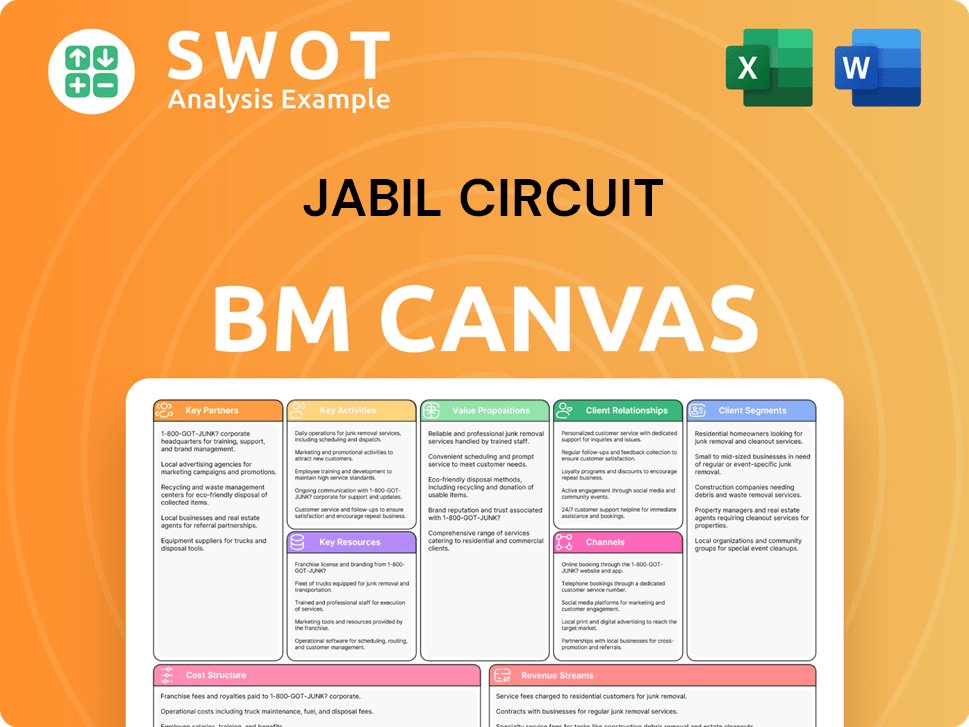
What is the Timeline of Key Events for Jabil Circuit?
The Jabil Circuit company has a rich history marked by significant milestones. Founded in 1966 in suburban Detroit, Michigan, by William E. Morean and James Golden, the company quickly established itself in the manufacturing sector. Relocating its headquarters to St. Petersburg, Florida, in 1982, Jabil expanded its operations and went public in 1993. Over the years, Jabil has expanded through strategic Jabil acquisitions, reaching revenues exceeding $1 billion by 1998. The company's commitment to innovation and strategic partnerships has solidified its position in the industry.
| Year | Key Event |
|---|---|
| 1966 | Jabil founded in suburban Detroit, Michigan, by William E. Morean and James Golden. |
| 1979 | Establishes a high-volume manufacturing partnership with General Motors (GM). |
| 1982 | Relocates headquarters to St. Petersburg, Florida. |
| 1993 | Becomes a publicly traded company on the New York Stock Exchange. |
| 1998 | Revenues exceed $1 billion for the first time. |
| 1999 | Acquires GET Manufacturing Inc. of Hong Kong, with revenues exceeding $2 billion. |
| 2001 | Added to the S&P 500 Index. |
| 2006 | Acquires Sypro Optics, marking a key expansion in its optics capabilities. |
| 2013 | William D. Morean retires, and Mark Mondello is appointed CEO. |
| 2017 | Acquires Clothing+, expanding into wearable technology. |
| 2023 (August) | Sells its mobility business in China to BYD. |
| 2023 (November) | Acquires Intel's Silicon Photonics business and ProcureAbility. |
| 2024 (March) | Recognized on the Fortune 2024 World's Most Admired Companies™ list. |
| 2025 (February 5) | Finalizes acquisition of Pharmaceutics International, Inc. (Pii), entering the CDMO sector. |
| 2025 (February 25) | Collaborates with Apptronik to scale production of Apollo humanoid robots. |
| 2025 (March 5) | Announces expansion into Gujarat, India, for a new factory in the photonics sector. |
| 2025 (April 1) | Launches 1.6T Pluggable Transceiver for data center and AI connectivity. |
Jabil is focused on high-growth sectors such as intelligent infrastructure, healthcare, and the electric vehicle (EV) market. The company is strategically positioned for continued growth in these areas. This strategic focus is expected to drive future revenue and market share expansion.
Jabil projects AI-related sales to reach $7.5 billion in fiscal year 2025, a 40% increase year-over-year. This significant increase highlights the company's strong focus on AI as a key growth driver. The expansion into AI reflects its commitment to innovation and technological advancement.
Jabil aims for a 6% operating margin in the medium term through cost optimization and improved factory utilization. The company targets an increase from the current 75% to 85%. This focus on efficiency is crucial for sustainable growth and profitability.
For the full fiscal year 2025, Jabil projects net revenue of $27.9 billion, a core operating margin of 5.4%, and core diluted EPS of $8.95. The company anticipates adjusted free cash flow to exceed $1.2 billion. These projections indicate a robust financial outlook and strong performance.
Jabil Circuit Porter's Five Forces Analysis
- Covers All 5 Competitive Forces in Detail
- Structured for Consultants, Students, and Founders
- 100% Editable in Microsoft Word & Excel
- Instant Digital Download – Use Immediately
- Compatible with Mac & PC – Fully Unlocked
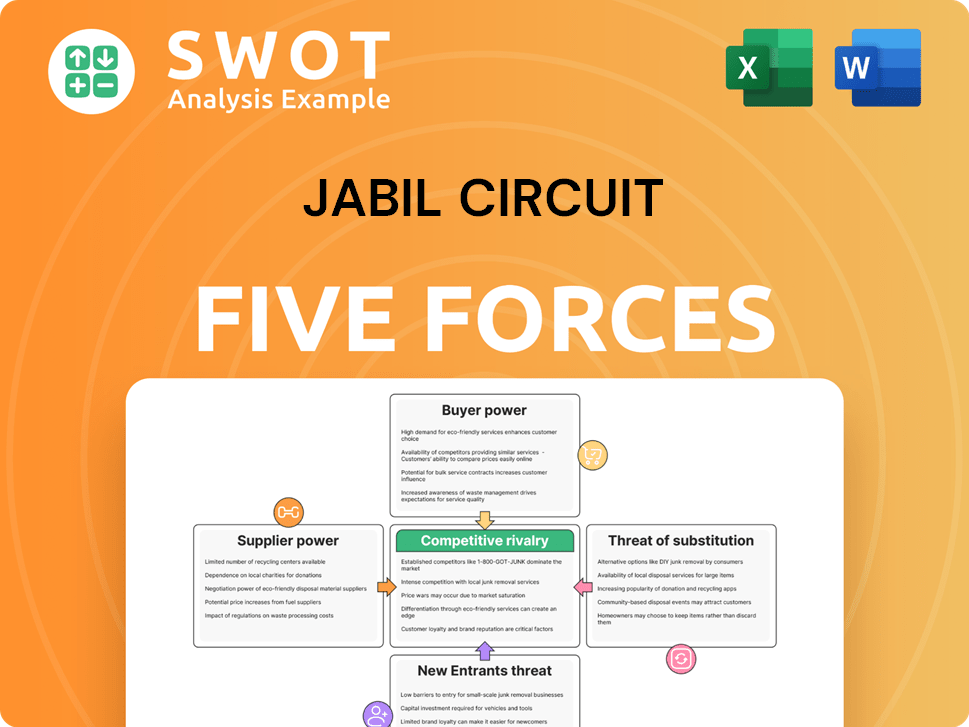
Related Blogs
- What is Competitive Landscape of Jabil Circuit Company?
- What is Growth Strategy and Future Prospects of Jabil Circuit Company?
- How Does Jabil Circuit Company Work?
- What is Sales and Marketing Strategy of Jabil Circuit Company?
- What is Brief History of Jabil Circuit Company?
- Who Owns Jabil Circuit Company?
- What is Customer Demographics and Target Market of Jabil Circuit Company?
Disclaimer
All information, articles, and product details provided on this website are for general informational and educational purposes only. We do not claim any ownership over, nor do we intend to infringe upon, any trademarks, copyrights, logos, brand names, or other intellectual property mentioned or depicted on this site. Such intellectual property remains the property of its respective owners, and any references here are made solely for identification or informational purposes, without implying any affiliation, endorsement, or partnership.
We make no representations or warranties, express or implied, regarding the accuracy, completeness, or suitability of any content or products presented. Nothing on this website should be construed as legal, tax, investment, financial, medical, or other professional advice. In addition, no part of this site—including articles or product references—constitutes a solicitation, recommendation, endorsement, advertisement, or offer to buy or sell any securities, franchises, or other financial instruments, particularly in jurisdictions where such activity would be unlawful.
All content is of a general nature and may not address the specific circumstances of any individual or entity. It is not a substitute for professional advice or services. Any actions you take based on the information provided here are strictly at your own risk. You accept full responsibility for any decisions or outcomes arising from your use of this website and agree to release us from any liability in connection with your use of, or reliance upon, the content or products found herein.